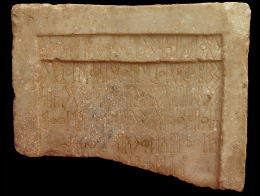
Corpus of Central Qatabanic Inscriptions
This collection includes more than 1,700 inscriptions which represent the documentation on the history of the Qataban kingdom from the 7th century BC to the 2nd century AD. The two main cities of the Qatabanian reign, Timnaʿ and Ḥinu az-Zurayr, can be found in the two valleys of wādī Bayḥān and wādī Ḥarīb. Like other South Arabian corpora, Qatabanic documentation is very discontinuous and is concentrated in certain periods and under certain kings.
This is derived in part from our findings but also from the fact that monumental inscriptions are strongly tied to political power and the affirmation of the state, so that the documentation is concentrated during the reigns of some kings.
Inscriptions of period A are short, with a text often intrinsically linked to the object, and with a marked "Sabaic" influence, in grammar, lexicon and formulary.
Phase B is the richest one, corresponding to the political flourishing of Qataban. For this reason period B has been divided into 2 phases, B1 and B2, on the basis of paleographic and linguistic criteria. Some of the most important construction and legal texts are dated to the period B1. The king constructs city walls, major irrigation works, roads and passes. Private subjects build palaces and tombs. The legal texts of ʾrby ʿm ḏ-Lbḥ testify the repetition of treaties between the Qatabanian kings and these families, who carried out a number of religious functions and tax-collecting.
Phase B2 contains interesting dedicatory inscriptions, as Arbach-Sayūn 1, a long text in which the historical account of the war campaigns, told with a narrative rhythm, is included in the body of the text, thus predating the style of the Sabaic inscriptions of the 3rd century AD. Some of the most beautiful objects of Qatabanian art, as well as perhaps South Arabian art in general, can be dated to period C. Many of them are objects and slabs in bronze, such as the splendidly crafted lions of Timnaʿ (Ja 120), or the female statuette dedicated by a woman (CIAS 47.11/o 1/F 72). The paleographic style of this period is the easiest to recognise. To the latest phase of Qatabanic documentation can be dated two large dedicatory inscriptions, textually parallel, commissioned by two women of high public position, who dedicate a bronze statue to the salvation of their king, the last king of Qataban history (CIAS 47.82/o 2 and CIAS 95.11/o 2). The funerary objects of the necropolis of Ḥayd Ibn ʿAqīl, bearing only onomastics, constitute a large part of the Qatabanic corpus. The vast number of proper names attested, engraved on stelae, their plinth, statues’ base, witnesses how important was in South Arabia the identification by individual names in a social context. The Qatabanic lexicon and its verbal system, to take the most outstanding examples, are clearly different from the Sabaic ones. The divergent linguistic traits, together with the converging isoglosses of the two languages, are fundamental to the reconstruction of the linguistic history - which is just the history tout-court - of South Arabia.
Phase B2 contains interesting dedicatory inscriptions, as Arbach-Sayūn 1, a long text in which the historical account of the war campaigns, told with a narrative rhythm, is included in the body of the text, thus predating the style of the Sabaic inscriptions of the 3rd century AD. Some of the most beautiful objects of Qatabanian art, as well as perhaps South Arabian art in general, can be dated to period C. Many of them are objects and slabs in bronze, such as the splendidly crafted lions of Timnaʿ (Ja 120), or the female statuette dedicated by a woman (CIAS 47.11/o 1/F 72). The paleographic style of this period is the easiest to recognise. To the latest phase of Qatabanic documentation can be dated two large dedicatory inscriptions, textually parallel, commissioned by two women of high public position, who dedicate a bronze statue to the salvation of their king, the last king of Qataban history (CIAS 47.82/o 2 and CIAS 95.11/o 2). The funerary objects of the necropolis of Ḥayd Ibn ʿAqīl, bearing only onomastics, constitute a large part of the Qatabanic corpus. The vast number of proper names attested, engraved on stelae, their plinth, statues’ base, witnesses how important was in South Arabia the identification by individual names in a social context. The Qatabanic lexicon and its verbal system, to take the most outstanding examples, are clearly different from the Sabaic ones. The divergent linguistic traits, together with the converging isoglosses of the two languages, are fundamental to the reconstruction of the linguistic history - which is just the history tout-court - of South Arabia.